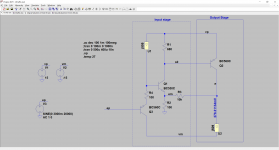The low impedance of the (inverting) input (let's say 20 Ohm) has the strange property that it does not load Rg (let's 200 Ohm). This has been approached in the thread.Common base configuration (CFA) has low impedance input while common emitter (VFA) has high one.
Could you, please, explain the opposite directions of the arrows ?
Arbitrary sign convention.
I can hear nor see you, Cheops is standing between us.Could you, please, explain the opposite directions of the arrows ?
Hans
You forget that one of the two people is calm, not agressive.Yet, it started out as a simple difference of opinion. I think that is how wars start.
Insert the small resistor as I suggested and you will see if the feedback current is arbitrarily entering the inverting input or getting out of it.Arbitrary sign convention.
The low impedance of the (inverting) input (let's say 20 Ohm) has the strange property that it does not load Rg (let's 200 Ohm). This has been approached in the thread.
Quite correct and fully in line with CFA theory at DC
Last edited:
I just copied very basic circuits which all the readers of this thread know.
I show three images, with arrows representing current in the following electrode of the input device and in the feedback network.
Two are towards a direction, the third one towards the other direction.
Which is the good one ?
There is necessarily an error.
I interpreted nothing.
To verify,
- insert a very low value resistor in the connection between the inverting input and the junction between Rf and Rg.
- measure the AC voltages (referenced to ground) at both ends of the resistor. One is higher than the other. It is up to you to draw the arrow.
This is not to support the legitimacy of devices being necessarily called CFA's or VFA's, however the current mirrors in chip VFA's and CFA's are current sources that can only source current into the Tz node resistor. This is for reasons they cannot sink currents back into their ideally infinite source impedances.
Hence, the inverting terminal can only source signal currents, hence with an outward pointing arrow. This seems ought to be agreeable as the starting point of further analysis.
Without elaborating, and contrary to my earlier opinion, VFA's and CFA's are accurately portrayed under normal circumstances. This is based upon the Ro of the buffered inverting terminal being compared in relation to the Thevenin equivalency of the feedback network.
In the brevity, CFA source resistances can be typically 50 Ohms, while VFA source resistances can be beyond 20K Ohm. It is considered that values in the parallel combination of Rf and Rg normally fall in between these two values, hence can differentiate a CFA from a VFA. This also leads to the conclusion that Thevenin equivalent resistances (the parallel combination of Rg and Rf) that fall below 50 Ohms turns a CFA into a VFA, and values exceeding 20K Ohm turns a VFA into a CFA.
Insert the small resistor as I suggested and you will see if the feedback current is arbitrarily entering the inverting input or getting out of it.
It does not matter the sign convention is arbitrary, this is arguing trivia.
Hi Hans,
I disagree.
1) the map is not the land
2) I can write V(s) = A(s)*s0, as the output stage is a voltage controlled source.
This is wrong.
Of course, a voltage controlled transfer function doesn't need input impedance. A commmon source or emitter transistor is a voltage controlled source and you don't know "a priori" its input impedance, you have to calculate it.
Do you mean Z(s) is known and fixed ?
I'm speechless that somebody can be so persistent in his denial of facts.
All models show that V(out) = I(in-) * Z(s).
I disagree.
1) the map is not the land
2) I can write V(s) = A(s)*s0, as the output stage is a voltage controlled source.
Thus whithout input current , no output voltage.
But for letting a current I(in-) flowing through the CFA's input impedance, there is no other way but to offer a certain Voltage at that point.
So the amount of volts are only used as the transport vehicle to facilitate Current I(in-).
There is no mathematical relation between output voltage and input voltage, nor is the input impedance showing up in the transfer function.
This is wrong.
Of course, a voltage controlled transfer function doesn't need input impedance. A commmon source or emitter transistor is a voltage controlled source and you don't know "a priori" its input impedance, you have to calculate it.
Excellent.This makes the voltage to be offered at the -Input amongst others a function of the unknown and varying input impedance.
But this is not the case for the current, being directly related through V(out) = I(in-) *Z(s).
Thus a CFA is completely controlled by current I(in-), and therefore its current feedback, end of discussion.
Hans
Do you mean Z(s) is known and fixed ?
Attachments
Two are towards a direction, the third one towards the other direction.
Which is the good one ?
There is necessarily an error.
I interpreted nothing.
Currents, like voltages, can be positive or negative. Arrow directions mean little on a schematic unless the associated meanings are further defined, for instance by naming the arrows and relating the names with equations.
I think I recall you arguing that since the current through Rf does not flow through the CFA's in (-), this can't be current feedback. If this is incorrect, please say so and disregard the rest of this post.
Consider the case in which in (-) is being fed by the Thevenin equivalent of the standard Vout, Rg, Rf circuit: a voltage source equal to Vout * Rg / (Rg + Rf) in series with a resistor Rfg = Rg || Rf. (The open loop output impedance is neglected here for simplicity, but could be accounted for.)
Surely the same current from the Thevenin voltage source flows through both Rfg and in (-). Can we agree that this can be called current feedback? If not, please say so and disregard the following.
in (-) cannot distinguish between these two circuits. The difference between them is the difference between the outputs and the feedback networks. Am I correct in assuming that this difference is enough for you to declare that the CFA does not employ current feedback?
The low impedance of the (inverting) input (let's say 20 Ohm) has the strange property that it does not load Rg (let's 200 Ohm). This has been approached in the thread.
Hi Forr,
Do you think Tryphon calculate the inverting input closed loop impedance before claiming it is low wrt Rg ?
Though I do miss him as well as some common acquaintances who chose to no longer participate here.
I agree
Jan,Yes, true, but the definition at the highest level says what is happening, not how to do it, not 'which road to take'. Early systems even had a man in the loop, and a fly-by-wire jetfighter has a man in the loop and actually is unstable without continuous feedback control of the flight characteristics.
Jan
I see some contradiction in your definition.
When the "how to do" or "which road to take" for feedback is unimportant, this whole discussion about Current Feedback and Voltage Feedback both clearly describing the "how to" and "which road was taken" wouldn't make sense.
When following this line, what remains is just and only FA isn't it ??
What should be mentioned when feeding back is the product (like current, voltage, temp, light or whatever) that ultimately controls and dominates an optimal production at the output.
Then we also have to discriminate between positive and negative feedback, where usually only the second leads to a stable system.
My attempt to a definition for feedback could be:
Bring the product created at the output, eventually after a possible conversion to a size and dimension, back to the input where it can take the dominant steering function of making the end product as close as possible after comparing it to what was originally envisioned at the start of the production.
With this wider description there is room for:
A VFA, voltage A out, Voltage -X*A in.
But also for a CFA, Voltage A out and Current -Y*A in.
For Car spraying quality feedback, measured paint thickness A out, spraying time -Z*A in, etc, etc.
Hans
It does not matter the sign convention is arbitrary, this is arguing trivia.
Are you stating then that the inverting terminal can source or sink current as independent of the direction of the current flow in the current mirrors?
Are you stating then that the inverting terminal can source or sink current as independent of the direction of the current flow in the current mirrors?
AC or DC?
Jan,
I see some contradiction in your definition.
When the "how to do" or "which road to take" for feedback is unimportant, this whole discussion about Current Feedback and Voltage Feedback both clearly describing the "how to" and "which road was taken" wouldn't make sense.
When following this line, what remains is just and only FA isn't it ??
Of course it does make sense. You can define 'travel' as going from A to B. But it makes a hell of a lot of difference whether you go by car, mule cart, train or bike. You wouldn't say that bikes and mule carts are the same thing because they both facilitate travel. They're two different ways of doing 'travel'.
Jan
Are you stating then that the inverting terminal can source or sink current as independent of the direction of the current flow in the current mirrors?
There are those here obviously determined to not listen to any reasoning along other than their predetermined path even to the point of silly comments.
Attachments
AC or DC?
AC as preceding any phase shifting.
AC as preceding any phase shifting.
I would think that they are dependent.
There are those here obviously determined to not listen to any reasoning along other than their predetermined path even to the point of silly comments.
Is that a picture of Waly?
- Home
- Amplifiers
- Solid State
- Current Feedback Amplifiers, not only a semantic problem?

